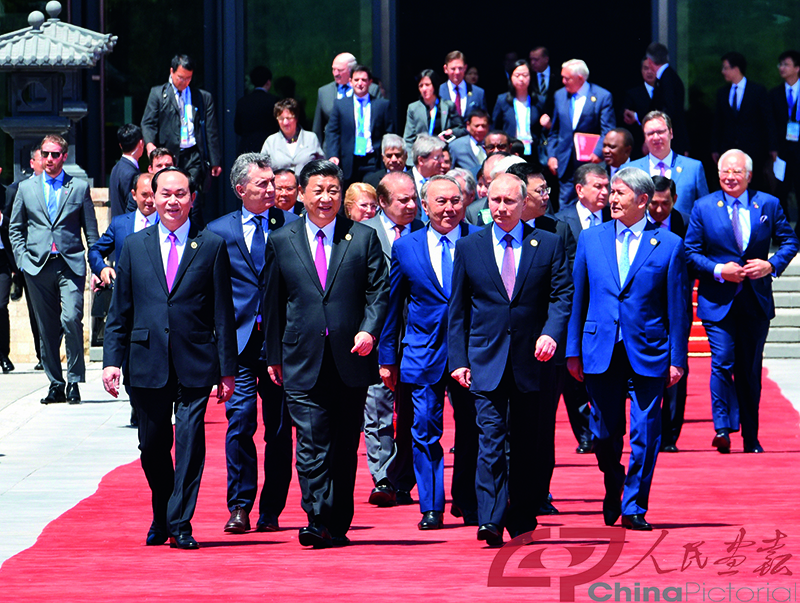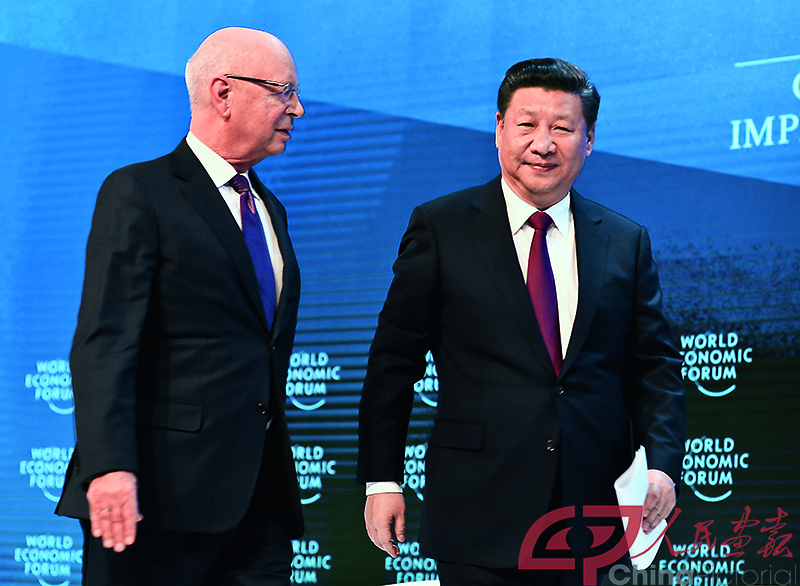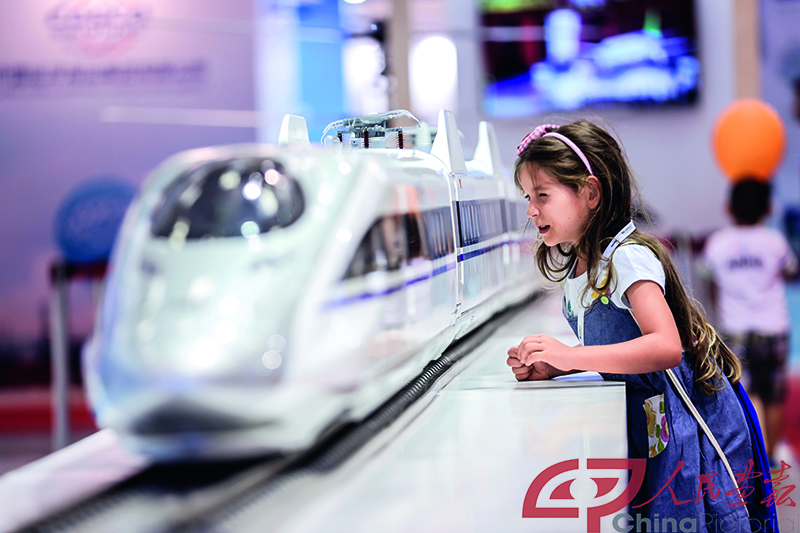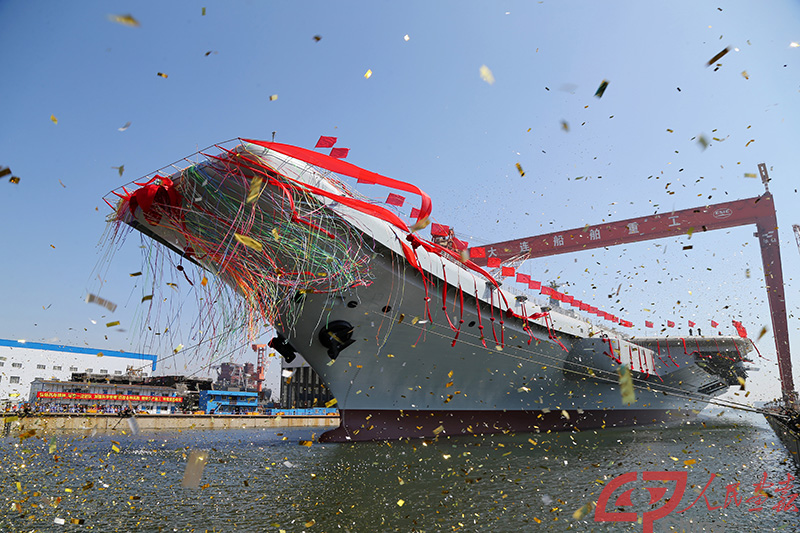2017,A Good Year for China

The world witnessed increasing uncertainty and many emerging challenges in 2017. Many are pondering in which direction humankind should steer its future development. After decades of unprecedented growth followed by landmark successes in the past year, perhaps China has some answers that would be universally beneficial.
China and the World
In 2017, problems such as terrorism, increasing refugee flow, regional conflict, poverty, unemployment and isolationism still plagued the world.
In this context, Chinese President Xi Jinping launched an initiative to build a community with a shared future for all mankind and proposed Chinese solutions to drive global economic growth and balance globalization—contributing Chinese wisdom to the whole world with an eye on solving common challenges.
On January 17, 2017, the World Economic Forum Annual Meeting commenced in Davos, Switzerland. In a context of mounting uncertainty arising from political changes in the United States and Europe amid surging anti-globalization sentiment and isolationism, President Xi’s speech at the meeting drew particular interest from participants from around the world. In the speech, Xi remarked, “World history shows that human civilization’s road has never been smooth and that mankind has accelerated progress by overcoming difficulties. No difficulty, however daunting, will stop mankind from advancing. When encountering difficulties, we should not complain about things that cannot be controlled, blame others, lose confidence or run away from responsibility. We should join hands and rise to the challenge.”

During the G20 summit in Hamburg on July 7 and 8, China’s role and influence in the world became front-page news in Western media. German newspaper Der Tagesspiegel commented that President Xi Jinping made a big statement as the leader of a responsible world power at the Hamburg summit. The New York Times remarked that President Xi Jinping’s attendance at the G20 summit in Hamburg positioned Beijing as “the globe’s newest, biggest defender of a multilateral, rules-based system.”
President Xi also attended the Asia-Pacific Economic Cooperation (APEC) Economic Leaders’ Meeting held from November 10 to 14 in Da Nang, Vietnam. In sharp contrast to U.S. President Donald Trump’s “America First”philosophy, Xi called for a defense of globalization and construction of more multilateral trade mechanisms and free trade areas, which won applause at the meeting. The Diplomat commented that Xi’s speeches in favor of globalization, free trade and multilateral organizations are more attractive to the world than any of the alternates.
“From Davos to Geneva, from Hamburg to Da Nang, President Xi delivered a series of important speeches, laying out China’s clear position on a range of issues and suggesting the way forward for the world economy while making major contributions to global governance,”noted Chinese Foreign Minister Wang Yi. “China is emerging as the most positive factor in the evolution of the international system and the most dynamic force for improving global governance. The Chinese Dream is increasingly linked with the dreams of the world.”
The approach of pursuing shared benefits through consultation and collaboration opens new pathways for eliminating deficits in global development and governance, achieving sustainable development and balancing globalization. The three upgraded pillars of economic, trade and financial cooperation, political and security cooperation, and people-to-people exchange have created brighter prospects for cooperation between BRICS countries.
From May 14 to 15, 2017, the Belt and Road Forum for International Cooperation was held in Beijing. Over the four years since President Xi proposed the Belt and oad Initiative, China has signed Belt and Road cooperation agreements with 80 countries and organizations, conducted institutionalized cooperation on industrial capacity with over 30 countries and built 75 overseas economic and trade cooperation zones in 24 countries under the Belt and Road framework. Chinese businesses have invested over US$50 billion and created nearly 200,000 local jobs in countries along the Belt and Road.
The Belt and Road Initiative is a successful example of China innovating solutions to help the entire world. The Belt and Road Forum for International Cooperation attracted enthusiastic attention from around the globe. France’s AFP reported that the forum not only strengthened China’s economic and trade connectivity with the outside world, but also showcased its efforts to oppose trade protectionism and defend economic globalization.
The 9th BRICS Summit, held in Xiamen from September 3 to 5, was another important international event hosted by China in 2017. President Xi Jinping delivered a series of significant speeches during the summit. The Washington Post quoted President Xi saying that “protectionism and inward-looking mentality are on the rise… Only openness delivers progress, and only inclusiveness sustains such progress.”

As a rising great power, China is committed to building a new type of major-country relationship with rationality and wisdom, safeguarding regional stability with honesty and responsibility and deepening cooperation and friendship with neighboring countries through pragmatism and communication.
In January 2017, Donald Trump was inaugurated as the 45th president of the United States, stirring up concern for the future of China-U.S. relations. Later, a series of high-level interactions between the two countries drew worldwide attention, including President Trump’s Lunar New Year message to President Xi, a phone call between the two presidents, Chinese State Councilor Yang Jiechi’s visit to the U.S., the meeting between Chinese and U.S. foreign ministers on the sidelines of the G20 Foreign Ministers’ Meeting in Bonn, and the first in-person meeting between President Xi and President Trump at the Mar-a-Largo estate in South Florida. China and the U.S. announced four-pronged high-level dialogue mechanisms covering topics such as diplomacy and security. The two countries agreed to launch a 100-day action plan to improve bilateral trade ties. Bloomberg quoted experts as saying that “the meeting between U.S. President Donald Trump and Chinese President Xi Jinping was a constructive step toward stronger ties.”
Soon after the conclusion of the 19th National Congress of the Communist Party of China (CPC), U.S. President Donald Trump made a state visit to China. The New York Times commented, “One tangible gain from Mr. Trump’s trip—US$250 billion worth of business agreements between American and Chinese companies—was viewed as a token of Chinese good will.”
In 2017, Chinese President Xi Jinping and his Russian counterpart Vladimir Putin exchanged visits and met five times. The two sides agreed to maintain consistent, close coordination on major issues concerning global strategic stability, forge greater synergy in development strategies that will revitalize Eurasia, and steer China-Russia strategic coordination toward higher levels and into more areas at greater depths. The China-Russia relationship has become a cornerstone of world peace and stability, fairness and justice and win-win cooperation.
In June 2017, Indian border troops trespassed into China’s Dong Lang area, arousing concerns that the two countries could fall into military conflict. However, the Chinese kept national interests in mind and maintained restraint throughout the ordeal. The event demonstrated not only the value and emphasis China places on its relationship with India but also its sincerity and sense of responsibility in maintaining regional peace and stability.
Last year, relations between China and the Republic of Korea (ROK) encountered headwinds due to deployment of the THAAD missile system. Since President Moon Jae-in took office, he placed greater focus on maintaining friendship and cooperation with China. The two sides reached agreement on handling the THAAD issue for the time being. On December 13, 2017, President Moon Jae-in paid a state visit to China. During his meeting with President Moon Jae-in, President Xi Jinping pointed out that China and the ROK are close neighbors and strategic cooperation partners. The two countries have made remarkable progress in exchange and cooperation in various fields, producing tremendous benefits for both sides since the establishment of diplomatic relations 25 years ago. There have been recent twists and turns in China-ROK relations which have only served to provide enlightenment for both sides on how to better create a future for bilateral relations on the basis of mutual respect for each other’s core interests.
In 2017, the Democratic People’s Republic of Korea (DPRK) conducted a total of six nuclear tests, and the Korean nuclear issue escalated tension in the region. On the Korean Peninsula nuclear issue, China has firmly stood by goals of upholding the international non-proliferation regime, safeguarding peace and stability of and denuclearizing the Peninsula, while remaining committed to resolving the issue through dialogue and negotiation. The international community has noticed that China has fully and strictly concurred on DPRK-related resolutions of the UN Security Council. While taking concrete actions to curb the DPRK’s nuclear and missile development, China has proposed a “suspension for suspension” strategy with the aim of creating conditions for resuming dialogue and negotiation.
China in the New Era
In his report to the 19th CPC National Congress, President Xi Jinping declared,“Chinese socialism’s entrance into a new era is, in the history of the development of the People’s Republic of China and the history of the development of the Chinese nation, of tremendous importance. In the history of the development of international socialism and the history of the development of human society it is of tremendous importance.”
Last year witnessed the 20th anniversary of Hong Kong’s return to China and the 90th anniversary of the founding of the Chinese People’s Liberation Army (PLA). Such celebrations not only kindled pride and patriotism in the hearts of the Chinese people, but also drew global attention.
July 1, 2017 marked the 20th anniversary of Hong Kong’s return to her motherland. From June 29 to July 1, President Xi Jinping visited Hong Kong to attend a celebration gala and the inaugural ceremony of the fifth-term government of the Hong Kong Special Administrative Region. He noted that the practice of “One Country, Two Systems”in Hong Kong is a success recognized by all.
Forbes commented that“The growth of the city [Hong Kong] was spectacular; the GDP almost doubling in the 20 years since.”Japan’s Nihon Keizai Shimbun quoted a Hong Kong businessman as saying that the prosperity of Hong Kong can be attributed to the implementation of “One Country, Two Systems,”and the Belt and Road Initiative presents a huge opportunity for the city’s future development.
On July 30, a military parade celebrating the 90th anniversary of the founding of the PLA attracted attention both at home and abroad. In his speech at the rally, President Xi declared that China’s army will resolutely safeguard national sovereignty, security and development interests, a quote that was grabbed by many foreign media organizations. Results of China’s military reform and modernization also drew worldwide interest. The Singapore-based newspaper Lianhe Zaobao commented that the appearance of more new military equipment at the parade evidenced China’s increasing transparency in military affairs.
On December 31, 2016, President Xi Jinping said in his New Year speech that when the 19th CPC National Congress convened in 2017, participants would draw a blueprint to build socialism with Chinese characteristics. The 19th CPC National Congress was a greatly important meeting that took place during the decisive stage of construction of a moderately prosperous society in all respects and at the critical moment as socialism with Chinese characteristics entered a new era. It was also a meeting of global significance as China strides closer to center stage in the world. The global media opined that in a time when international situations are undergoing profound changes, the 19th CPC National Congress is not only crucial to China’s future development, but also heavily influential on the world.
Foreign media organizations interpreted the important meaning and influence of the report made by President Xi at the congress from a variety of perspectives. They surmised that the report outlines a roadmap for China’s development in the decades to come and sets a detailed blueprint for the realization of the Chinese Dream, as well as that Xi Jinping Thought on Socialism with Chinese Characteristics for a New Era will lead China to new achievements. U.S News & World Report published an article titled “What China’s National Congress Means for the U.S.,” in which it printed: “The results could influence whether Beijing will become more willing to cooperate on critical but contentious issues that matter a lot to the United States.”The Australian Broadcasting Corporation (ABC) commented that since China is Australia’s largest trade partner, the economic policies determined at the 19th CPC National Congress will undoubtedly influence the country.
In 2017, China’s economy realized moderate but sound growth as various reforms were pushed deeper and broader. In particular, supply-side structural reform has produced promising early results.
China’s remarkable achievements in economic growth last year inspired confidence. Data from research group Euromonitor International showed that the average wages in China’s manufacturing sector have surpassed that of Latin America. The Financial Times opined that this development testifies to the progress China has made in improving the living standards of its people. The Economist pointed out in an article that China has become a financial tech leader and witnessed especially impressive rapid development in mobile payments, online lending and internet investment. Bloomberg reported that statistics released by the Center for European Economic Research, Standard Chartered Bank and other international financial institutions show China’s economy is becoming stronger and more promising.

On December 14, the National Bureau of Statistics of China released data on the country’s macro economy in the first 11 months of 2017. Mao Shengyong, spokesperson of the bureau, summarized the current situations of China’s economy as follows: First, the stable operation of China’s economy is showing strong tenacity. Second, the optimization of China’s economic structure has produced many highlights. Third, China is soundly improving the quality and efficiency of its economic growth. This is not only demonstrated by favorable outlooks for China’s economy, but also reinforced by its move to build a modernized economic system and achieve high-quality development, which has deepened supply-side structural reform, promoting stable growth, economic restructuring, livelihood improvement and risk prevention while accelerating healthy economic and social development for the long-term.

In 2017, China realized outstanding scientific and technological achievements in fields such as expeditions to space and into the ocean, high-speed rails, and supercomputing, which has raised eyebrows around the world when coupled with China’s economic growth.
On April 20, 2017, China’s first cargo spacecraft, Tianzhou-1, blasted into space from the Wenchang Space Launch Center. “China has launched its first domestically-engineered cargo spacecraft, a crucial step in Beijing’s goal to launch and resupply a manned space station by 2022,”reported The Financial Times. A few days later, on April 26, China launched its first domestically-made aircraft carrier, which was described by The Wall Street Journal as “a demonstration of the growing technical sophistication of its defense industries and determination to safeguard its maritime territorial claims and crucial trade routes.”On May 5, 2017, the C919, China’s first homegrown large passenger jet to meet world-class standards, completed its maiden flight at Shanghai Pudong International Airport. Many foreign media organizations believed that the development testified to China’s ambitious commitment to develop a high-tech economy and a crucial step toward great capabilities in aviation.

On June 15, 2017, China’s first X-ray astronomy satellite, Huiyan, was sent into space atop a Long March-4B rocket. On September 29, China launched three remote sensing satellites on a Long March-2C rocket. On November 5, China launched two BeiDou-3 satellites into space via a single carrier rocket to support its global navigation and positioning network. On November 13, the TOP500 supercomputers list was officially released. China’s Sunway TaihuLight and Milky Way-2 maintained the first and second places, respectively, for the fourth time.
In 2017, China accomplished remarkable achievements in realms of politics, economics, diplomacy and science and technology while playing a major role in regional and global affairs by contributing Chinese wisdom and solutions.